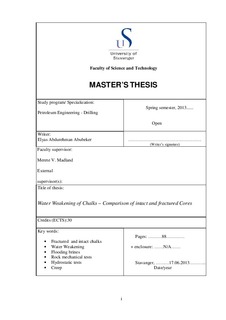| dc.contributor.author | Abubeker, Elyas | |
| dc.date.accessioned | 2013-11-11T09:41:45Z | |
| dc.date.available | 2013-11-11T09:41:45Z | |
| dc.date.issued | 2013-06-17 | |
| dc.identifier.uri | http://hdl.handle.net/11250/183510 | |
| dc.description | Master's thesis in Petroleum engineering | no_NO |
| dc.description.abstract | Even though Chemical induced compaction on high porosity chalks has been studied extensively, little attention was given to the impacts of fractures when chalk is exposed to various flooding brines. Due to the nature of fractures, the fluid transport mechanism down inside reservoirs is different between intact and fractured reservoirs and the observed results for intact high porosity chalk may not explain water weakening effects on fractured chalks. In addition, chemically induced weakening seems to be triggered by precipitation of secondary minerals which further cause increased dissolution. These new precipitates may be difficult to detect and quantify by conventional scanning electron microscope (SEM) investigations, however, from a previous experiment these precipitates could easily be found dominantly in the fracture.
The main objective of this study was to analyze and compare the effects of synthetic sea water (SSW), 0.219M MgCl2 and 0.657M NaCl brines on the mechanical behavior of intact and fractured chalk samples, based on mechanical experiments carried out using hydraulically operated triaxial cells at 130oC. Chemical analyses, porosity calculations and SEM analyses were made to further investigate fluid transport mechanisms and the formation of newly precipitated minerals.
The results showed that, independent of the type of brines, the presence of fractures inside the fractured cores resulted in lower chemical deformation compared to intact cores although the impact of fractures in reducing the deformation rate was magnified when the cores were flooded with SSW. However, the presence of fractures inside the tested cores had not totally stopped the water weakening effect as evidenced by the mechanical and chemical analyses results. This implied that the injected brines not only flow through the fractures but also diffused in to the core matrix to further cause deformation. This also fits very well with fracture/matrix model developed by Anderson & Evje (2012). Finally, SEM analysis results showed the formation of magnesium-bearing minerals at the fracture walls. | no_NO |
| dc.language.iso | eng | no_NO |
| dc.publisher | University of Stavanger, Norway | no_NO |
| dc.relation.ispartofseries | Masteroppgave/UIS-TN-IPT/2013; | |
| dc.subject | petroleumsteknologi | no_NO |
| dc.subject | chalk | no_NO |
| dc.subject | water weakening | no_NO |
| dc.subject | flooding brines | no_NO |
| dc.subject | rock mechanical tests | no_NO |
| dc.subject | hydrostatic tests | no_NO |
| dc.subject | creep | no_NO |
| dc.title | Water weakening of chalks - comparsion of intact and fractured cores | no_NO |
| dc.type | Master thesis | no_NO |
| dc.subject.nsi | VDP::Technology: 500::Rock and petroleum disciplines: 510::Petroleum engineering: 512 | no_NO |
